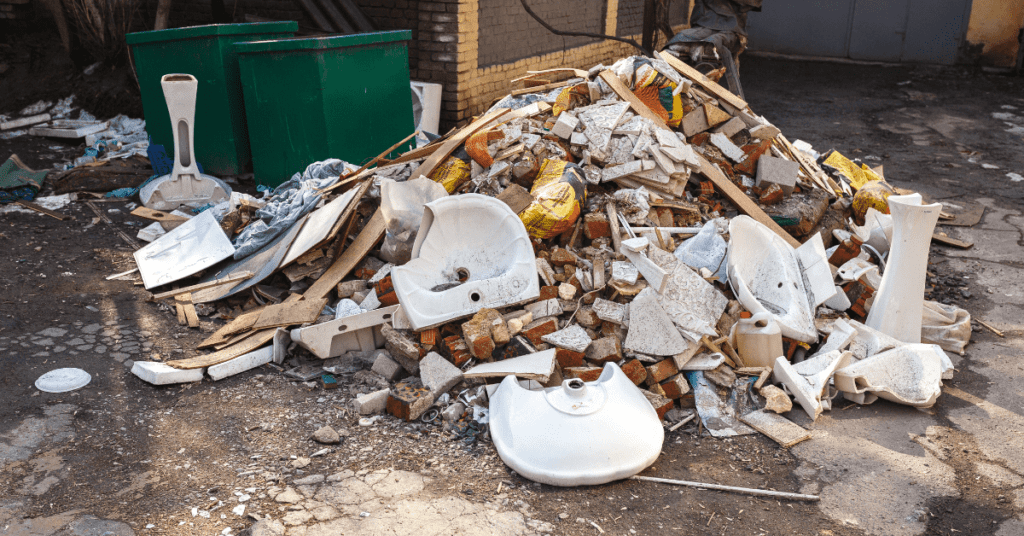Building sites in NSW have specific requirements for waste management. This post outlines what a building contractor needs to know to manage construction waste on site. To avoid hefty fines, you must ensure you have appropriate waste management in place, including skip bins to store the waste.
Pre-Construction Requirements
-
- Waste Management Plan (WMP):
-
- Submission: A WMP must be submitted and approved as part of the Development Application (DA).
-
- Content: The plan should outline strategies for waste reduction, recycling, and disposal during construction, demolition, and ongoing site operations.
-
- Waste Management Plan (WMP):
On-Site Waste Management
-
- Waste Segregation:
-
- Categories: Waste must be separated into distinct categories such as recyclable (metal, timber, concrete), non-recyclable, hazardous, and non-hazardous.
-
- Containers: Appropriate containers or skips must be provided for each waste category.
-
- Waste Segregation:
-
- Containment and Storage:
-
- Containment: Waste must be contained to prevent littering and contamination of surrounding areas.
-
- Secure Storage: Hazardous materials must be securely stored to prevent environmental contamination and health hazards.
-
- Containment and Storage:
-
- Labeling:
-
- Clear Labels: All waste containers must be clearly labeled to ensure proper segregation and prevent cross-contamination.
-
- Labeling:
Recycling and Disposal
-
- Recycling Targets:
-
- Minimum Targets: Aim to recycle a minimum of 80% of construction and demolition waste.
-
- Material Reuse: Promote the reuse of materials where possible.
-
- Recycling Targets:
-
- Licensed Facilities:
-
- Disposal Sites: Waste must be disposed of at licensed waste management facilities.
-
- Proof of Disposal: Documentation or receipts from licensed facilities must be kept as proof of proper disposal.
-
- Licensed Facilities:
Site Cleanliness and Safety
-
- Regular Waste Removal:
-
- Frequency: Waste must be regularly removed from the site to maintain cleanliness and safety.
-
- Daily Inspections: Conduct daily inspections to ensure waste management practices are being followed.
-
- Regular Waste Removal:
-
- Dust and Debris Control:
-
- Dust Suppression: Implement measures such as water spraying or dust screens to control dust and debris.
-
- Debris Containment: Ensure debris is contained and not spread to adjacent properties or public areas.
-
- Dust and Debris Control:
Documentation and Reporting
-
- Record Keeping:
-
- Waste Records: Maintain detailed records of all waste generated, including types, quantities, and disposal methods.
-
- Inspection Logs: Keep logs of site inspections and waste management activities.
-
- Record Keeping:
-
- Compliance Reporting:
-
- Regular Reports: Submit regular compliance reports to the local council, detailing adherence to the WMP and any deviations or issues encountered.
-
- Compliance Reporting:
Hazardous Waste Management
-
- Special Handling Procedures:
-
- Asbestos: Follow strict guidelines for the identification, removal, and disposal of asbestos-containing materials.
-
- Chemical Waste: Store and dispose of chemical wastes according to environmental regulations.
-
- Special Handling Procedures:
Penalties for Non-Compliance
-
- Enforcement Actions:
-
- Fines and Penalties: Non-compliance with waste management regulations can result in fines, stop-work orders, or other enforcement actions.
-
- Remediation Orders: The council may issue orders for the remediation of improperly managed waste.
-
- Enforcement Actions:
Local Council-Specific Requirements
-
- Consult Local Guidelines:
-
- Council Websites: Each local council in the Greater Sydney area may have additional specific requirements. Consult the relevant council’s website or contact their planning department for detailed guidelines.
-
- Consult Local Guidelines:
By adhering to these requirements, building sites in the Greater Sydney area can ensure compliance with local regulations and contribute to effective waste management and environmental protection.

